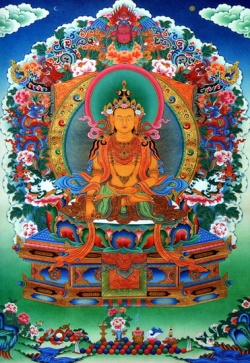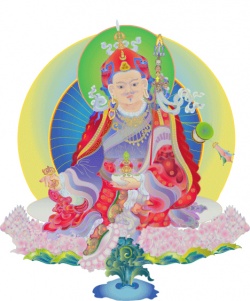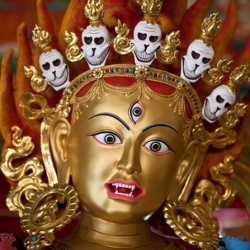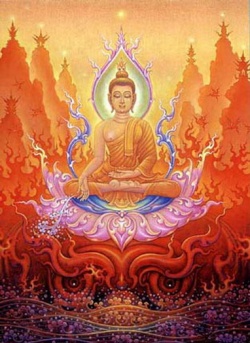The Appearance of Emptiness Through Time
By Rudolph Bauer, Phd
The word Emptiness has many various meanings. The experience of awareness becoming aware of its own self opens the experience of emptiness in a most direct manner. Experientially emptiness has many faces. Sometimes the face of emptiness is a void or abyss like experience. This abyss can open the unhappy experience of falling and falling and falling. This void experience can at times open the experience of disappearing and dissolving into a terrifying nothingness. And sometimes emptiness is experienced as no thingness. Sometimes emptiness is experience like endless and infinite space. Sometimes emptiness is experienced as unbound openness. Sometimes emptiness is experienced as deep unmoving stillness, stillness of movement and stillness of sound. Sometimes emptiness is experienced as bliss, vast bliss. All these variations of experience unfold over time as one becomes aware of their own awareness. Sometimes emptiness is experienced as freedom of pure potentiality. Often the word sunyata implies the experience and nature of emptiness. The personal experience of emptiness is a vast range experience often beyond words and language. The human range of experiencing emptiness is vast and ineffable. The experience of emptiness can range from nihilistic experience that can not be thought to the positive experience that is unbound bliss as gnosis. This wide range of meaning of emptiness is not only personally experiential but there is vast range of the historical cultural unfolding of the appearance of emptiness and articulation of emptiness by the various spiritual traditions. Over time the phenomena of emptiness has been articulated in various ways, and at times in ways that are in opposition to each other.
Historically, emptiness has had many meanings in the history of eastern philosophy both in Buddhism and Hinduism. I will briefly describe some of the meanings ascribed to emptiness in Tibetan Buddhism. I will describe the appearance of emptiness and the unfolding of the understanding of emptiness over time.
Emptiness as Dependent Origination
In early Buddhism (approximately 400 BC through to the second century AD) the understanding about emptiness was primarily dependent origination. During the time of Buddha Shakyamuni and the Brahmanic scriptures, the Vedas had not be written down. Buddha’s own words or understanding was not to be written for several centuries. For the Tibetans, this was the first turning of the wheel of teaching and was to be continued on within the ongoing revelation of the Mahayana and Vajrayana teachings. Another way of thinking is that the early teachings of Buddhism was part of an ongoing, unfolding process of reformulation and self revelation. For the Tibetans the word Buddha referred less to the historical person than to the universal process of self revelation.
Early Buddhism was preoccupied with causality as karma. The word karma itself means action. The early understanding of mindfulness was a total awareness of the immediate situation. Realization or enlightenment has the implication of being able to read the karma of the situation; the knowingness that allows the reading of the subtle causes and results. Early Buddhism grew out of a shamanistic context. Its formulation was none the less within a clerical context with the emphasis on monastic life and spiritual rules of behavior. This shamanistic clerical tension manifested early in the Buddhist tradition and has continued to manifest throughout time; the dynamic tension of the rational and logical with the magical and esoteric.
Buddha gave subtle insight into the relational nature of phenomena in his early teachings. There is the famous formula pratityasamutpada, which is dependent origination. Dependent origination understanding was foremost philosophically in early Buddhism. There is this ceaseless arising of mutual causation. The emptiness of phenomena is described as all phenomena are without substance and are empty since they do not exist independently. Dependent origination reflects the understanding that phenomena are the result of infinite multiple causalities. Interdependent causalities bring phenomena into a temporal and time limited existence. Interdependent phenomena are empty and have no basis within them. Every and all phenomena are a result of multiple infinite causalities. This causal result is phenomena and the resulted phenomena, in turn, enters the sequence of causality and in turn contributes to innumerable causal sequencing resulting in infinite phenomena arising. Interdependence is the meaning of emptiness. This experience of emptiness is experienced as the view of phenomena within our own self and as well as our view of all external phenomena.
Because every phenomenon is the result of causes outside of its own being, its own being is empty and contingent. The self concept was considering the occurrence of attributions and reality was regarded as some sense real. Reality was regarded as somewhat real as the subject and object implies each other, or co-emergent with each other. By self concept we may use the contemporary language of self representation. Self concept means how I represent myself to myself on the level of ideation or representational thinking. In this phrasing the sense of self or sense of subjectivity becomes an ideational and mental configuration.
Some people interpret this vast infinite interdependency as an empty process with empty results. They consider this is a mechanistic approach to emptiness. This view is there is simply this unending process of events without basis, without source or without end. This interdependent view is considered by some to be nihilistic. In this view of emptiness there is neither cosmological source nor intrinsic meaning. Some think this dependent origination can be also understood beyond the rationalistic. Dependent origination frame can be viewed from within the shamanistic frame. From within the shamanistic frame this would imply the power of unbound resonance, the vast magical net of radiant luminous energy that makes up the universe. This is implies a cosmological framing of the vast relational reality of the energetic luminous universe.
Unthinkableness of Emptiness
In time (1st or 2nd century AD) the meaning of the appearance of emptiness was described by Nagarjuna. He formulated the Madhyamaka traditions. This great tradition was part of the unfolding of the Mahayana tradition. This was another turning of the wheel of dharma, the wheel of understanding. Mahayana or great vehicle was a vast shift in the experience and projection of Buddhism. Mahayana and Madhyamaka are not the same. Mahayana was a vast shift in understanding and practice of Buddhism and Madhyamaka was the major philosophical part of this shift.
The Madhyamaka tradition is an epistemological tradition. Epistemological traditions focus on what we know, how we know, and if we can know. This epistemological tradition of Madhyamaka suggests that emptiness means empty of meaning and empty of signification. This emptiness of meaning suggests that emptiness can not be thought and neither can emptiness be conceptualized or linguistically represented. In a profound way, no signifier actually can signify emptiness. So this place of emptiness is a place without reference and without signification. This emptiness is the essence of phenomena or the essence of everything about which nothing can be said or thought. This is an epistemological and deconstructive approach to emptiness. In a way, the methodology of approaching emptiness is by deconstruction of both meaning and attribution of meaning. This deconstructed event is experienced beyond language and words. This view has nihilistic sides (no meaning) as well as being powerful in its epistemological openness which is free of language attribution.
Madhyamaka orientation was also a response to the concreteness of earlier Buddhist formulations of mind and awareness. Nagarjuna‘s work challenges some of the fundamental concrete language and imagery of the Abhidharma. Nagarjuna used rationalistic thinking to deconstruct the rationalistic Indian Buddhist philosophy of the day. Nagarjuna attempted to logically prove that the logical assertions about the nature of reality are inconsistent and useless assertions about emptiness. All language and rational thought takes us away from sunyata. The mind can not lead us into emptiness and can only distract us from the non conceptual experience of emptiness.
Madhyamaka does have limitations. A limitation is that Madhyamaka seems to make no active understanding or intuition as to phenomena of emptiness. Madhyamaka makes no attribution as to the indivisibility of phenomena and emptiness. The dimension of phenomena is simply left out of the Madhyamaka. Phenomena is left as unsaid and unthought. Within this lack of inclusion of phenomena there is a loss of the understanding of the non duality of appearance and emptiness. The presentation of Madhyamaka lacks reference to phenomena that does reflect the non-duality of form and emptiness as expressed in the heart sutra. The non-duality of relative truth and ultimate truth is by passed and unsaid. The dynamic aspect of radiance is unspoken and un-recognized in Madhyamaka.
Nonetheless, the actuality of the great compassion as sunyata is spoken and signified. The bodhichitta is also expressed and signified. The sambhogakaya dimension is also relatively unsaid, as is the nirmanakaya dimension. The Madhyamaka is an epistemological presentation of the dharmakaya via the path of negativity. What is not rather then what is.
It was on the basis of a group of Mahayana sutras the Prajnaparamita sutras that Nagarjuna created Madhyamaka philosophy. Prajnaparamita is the “Perfection of Wisdom” and means going beyond. Cutting through dualistic thinking, conceptual thinking; into experience of wisdom. The Madhyamaka uses rational thinking in cutting through rational thinking and understanding. In this approach, he deconstructs causality and all and any assertions that can be made about nature of reality or emptiness or sunyata. The cessation of conceptualization will itself transform samsara into nirvana and brings forth enlightenment.
Nagarjuna says emptiness is essentially compassion and compassion is emptiness. Ultimately the Madhyamaka philosophy opens the doorway to non-conceptual actuality of compassion. Similar to Madhyamaka methodology is the post modern philosopher Derrida’s methodology which deconstructs language and its meaning. This path of negation is also present in forms of Vedic philosophy as well as in Christian theology.
Emptiness as Buddha Nature
The next major tradition to unfold within the Mahayana was Yogacara originated by Asanga around the fourth century. The Prajnaparamita was considered the second turning of the wheel of dharma. The later sutras that followed Nagarjuna were considered the third turning. The Yogacara reflects a number of sutras, especially the five teachings of Maitreya revealed by Asanga. In the teachings of Maitreya, the understanding of the Tathagatagarbha clearing arose and is translated as Buddha Nature. This understanding and actuality of Buddha nature was specifically developed in the Uttaratantra. The Uttaratantra is one of the five teachings of Maitreya. This tradition of the givenness of seeds of enlightenment as the innate Buddha nature is understood to be within everyone and all sentient beings. The Tathagatagarbha doctrine is significant here as representing a contrasting pole in the presentation of Buddhism to the Madhyamaka philosophy of Nagarjuna. The Tathagatagarbha doctrine provided the basis for a different way of conceptualizing the process of enlightenment. Rather than a progress along a path in which the path is primarily one of purification, the Tathagatagarbha perspective understood the attainment of Buddhahood as the uncovering of potential that was always there. The path is the path of experiencing the underlying sublime structure of reality. This arising of the Uttaratantra tantra and the Tathagatagarbha gave cosmological base to dependent origination. This primordial awareness as Buddha nature became the primal cause of dependent origination. This is an amazing shift and there is the opening for the Vajrayana to unfold. Within this formulation there can be an implicit theism. Within this understanding, phenomenon was also included into the path of realization.
The Yogacara also provided a frame to hold the relationships between conventional reality or relative truth and the ultimate truth. The realm of phenomena was being integrated into the ultimate reality. The two truths understanding contrast our ordinary perception of reality with the absolute or ultimate truth.
Tathagatagarbha understanding is different than the Madhyamaka approach. Rather then the rational descriptions of the illusion of samsara there is the beginning attempts to experience the indivisibleness between view of phenomena and the enlightened state. This view is closer to the shamanistic view of meditative practice. The Madhyamaka descriptions are negative and deconstruct experience. The Yogacara was the view of yogis and meditators. The Nyingmapa tradition or the old translation school manifest the positive descriptions of primordial awareness as emptiness that is neither void nor dead. Rather, primordial awareness is alive and luminous radiance and is the source of phenomena and the possibility of experience of the indivisibleness between phenomena and emptiness. The Tathagatagarbha was emptiness but within each person it is the base of experience and the world. Buddha nature is emptiness, which is alive and compassionate and is knowingness or gnosis.
Emptiness as Cosmological Radiance Embodied: The Path of the Tantra
Within this formulation of the tantra, emptiness is primordial awareness that manifests the three kayas. This next unfolding was the revelation of the great tantras and the Vajrayana and Mantrayana paths. The arising of the understanding of emptiness as radiant light and bliss. . This period was from the fourth through the 12th century. These great tantras arose, which elaborated the practice of deities and the cosmology of the deities and dakinis. The world of awareness as being multi-dimensional was unfolding as dharmakaya, sambhogakaya and nirmanakaya.
Dependent origination is now ultimately light. Emptiness is understood to be the openness of spaciousness, luminous radiance. And this radiant light is the great compassion that creates everything and manifests everything directly ceaselessly. Since luminous emptiness was manifesting the infinite circumstances of dependent origination, dependent origination was also light. So the world is fused with light as light, and the map of Indra reflects this understanding of the interpenetration of energy and light. The indivisibleness of phenomena and luminous emptiness and luminous emptiness and phenomena is central to the tantric practice.. Also, the field of light can be located within the human body but is also beyond the body. Hence, there is this interfusion of the world of beings as light. This allows for extension to place us within the other directly and not just by words or modeling but by extension and transmission of awareness itself. The time period of the tantras was an extension of the great sutra’s and goes from about 400 A D through 1200 A D. The Guhyasamaja tantra, one of the major Anuttarayoga tantras may date as early as fourth century. New tantras continued to appear until the last stages of Indian Buddhism. One of the most important tantras for the Tibetans was the Kalachakra tantra. This tantra appeared in India not long before the destruction of Buddhist monasteries by Islamic armies.
The old tantras were transmitted to Tibet during the eight century. The major sources of the new tantras were transmitted two centuries later. Some of the major tantras concerning the supreme siddhis of enlightenment were the Hevajra, the Guhyasamaja, the Chakrasamvara, Kalachakra and the Guhyagarbha tantra. In this understanding, emptiness becomes positive, alive, luminous radiance, potentiality and is embodied as human awareness itself.
Indivisibleness of Emptiness and Phenomena
In the old translation traditions of Nyingma tradition phenomena is brought deeply into understanding of the essential relationship between luminous emptiness and phenomena. The understanding was the non-duality or the indivisibility of phenomena and luminous emptiness was essential to the path of realization. The oneness of relative truth and ultimate truth is an essential aspect of the Vajrayana path. The meaning of heart sutra is completed explicitly. The early understanding of sutra was emptiness alone. And the later understanding was the indivisibility of form and emptiness and emptiness and form. There is the moving away from emptiness as void alone to the understanding of emptiness as potentiality and source of manifestation of the world and the archetypical energies as the deities and dakinis. There is the recognition of the divinity of appearance and the divinity of experience within the Vajrayana. The Nirmanakaya dimension is included in the drama of realization.
The arising of Dzogchen during the 8th and 9th centuries was the most exquisite understanding of the indivisibleness of phenomena and luminous emptiness. The indivisibility of relative phenomena and absolute truth was completed within Dzogchen. There is much speculation since the origins of Dzogchen are mysterious that Chan Buddhism influenced the arising of Dzogchen. Other influences were the Indian Mahasiddha tradition, Bon, Indian Yogacara /Tathagatagarbha understanding, Hindu Kashmir Shaivism, the Mahayoga tantras, and even Gnosticism. Of great influence was the fundamental Mahayoga text of the Nyingma School, the Guhyagarbha Tantra.






